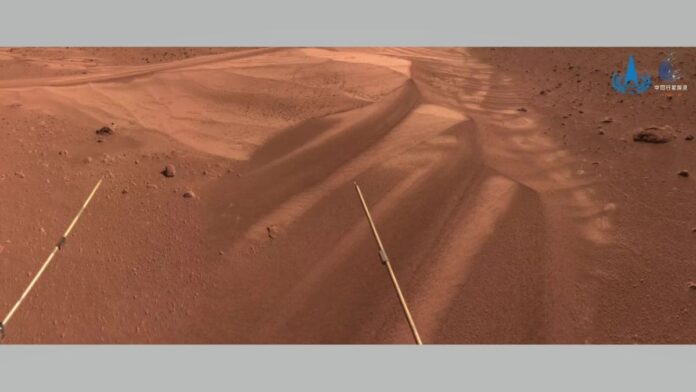Scientists studying data from China’s Zhurong rover have for the first time found cracked layers on tiny Martian dunes, which imply the Red Planet was a salt-rich watery world as recently as 400,000 years ago.
Since landing in Mars’ northern hemisphere in May 2021, the rover has rolled close to four nearby crescent-shaped dunes in the Utopia Planitia region to investigate their surface composition. All four of the miniature, wind-formed geological features are coated with thin, ubiquitously fractured crusts and ridges that formed thanks to melting small pockets of “modern water” sometime between 1.4 million years to 400,000 years ago, according to a new paper (opens in new tab) published Friday (April 28).
“This means a more recent time in Martian history,” Xiaoguang Qin, a scientist at the Chinese Academy of Sciences in Beijing and an author of the new study, told Space.com.
Related: Water on Mars: Exploration & evidence
Scientists have long thought that early Mars harbored abundant liquid water about three billion years ago. But dramatic climate changes froze much of it as ice now locked in poles and left the bulk of the planet parched.
The dunes Zhurong explored are close to its landing site in the planet’s northern hemisphere — far from the north pole — are just shy of 50 to 100 feet (15 to 30 meters) long and about 3 feet (1 m) tall. Latest findings from analyzing images and data sent home by Zhurong and its Tianwen 1 orbiter companion show that appreciable amounts of water from the planet’s icy polar regions wafted to lower latitudes a few million years ago, settling atop the Utopia Planitia dunes.
When Zhurong ventured close to its target dunes, which are pint-sized compared to the massive two-story ones NASA’s Curiosity rover studied elsewhere on Mars, the laser-induced breakdown spectrometer (MarSCoDe) instrument onboard the rover zapped sand grains into millimeter-sized particles. Their chemical makeup revealed hydrated minerals like sulfates, silica, iron oxide and chlorides. According to the study team, these minerals formed in the presence of water at low latitudes in the late Amazonian era on Mars, which scientists previously thought was bone-dry.
Researchers say water vapor traveled from Martian poles to lower latitudes like Zhurong’s spot a few million years ago, when the planet’s polar ice caps released high amounts of water vapor, thanks to a different tilt that had Mars’ poles pointed more directly toward the sun. Frigid temperatures on the wobbling planet condensed the drifting vapor and dropped it as snow far from the poles, according to the latest study.
Mars’ tilt changes over a 124,000-year cycle, so “this offers a replenishing mechanism for vapor in the atmosphere to form frost or snow at low latitudes where the Zhurong rover has landed,” Qin told Space.com. But “no water ice was detected by any instrument on the Zhurong rover.”
Instead, in the same way that salting roads on Earth melts icy patches during storms, salts in Martian sand dunes warmed the fallen snow and thawed it enough to form saltwater. The process also formed minerals such as silica and ferric oxides, which Zhurong spotted, researchers say.
The saltwater, however, didn’t stay around for long. Temperatures on Mars swing wildly and spike in the mornings between 5 a.m. and 6 a.m., so the saltwater evaporated and left behind salt and other newly formed minerals that later seeped between the dune’s sand grains, cementing them to form a crust, according to the study.
The crust that formed atop the dunes, which runs just 0.5 inches (1.25 centimeters) to 3 inches (1.7 cm) deep, likely materialized in as quickly as one year, because the loose dunes wouldn’t stay in place long enough to solidify across millenia. It then cracked as high temperatures dehydrated it so much that they “should be hard and resist wind erosion,” Qin said.
“The phenomenon was documented at one site, but it should be applicable to a fairly large fraction of Mars’ surface at similar latitudes,” Manasvi Lingam, an assistant professor of astrobiology at the Florida Institute of Technology who wasn’t involved in the new research, told Space.com.
Since Zhurong, which is now suffocating under dust-coated solar panels, has revealed water activity on top of and inside salty Martian dunes, researchers of the new study propose future missions to search for salt-tolerant microbes, perhaps like brine shrimp or pickleweed residing in Utah’s Great Salt Lake in the United States.
This research is described in a paper (opens in new tab) published Friday (April 28) in the journal Science Advances.
Follow Sharmila Kuthunur on Twitter @Sharmilakg (opens in new tab). Follow us @Spacedotcom (opens in new tab), or on Facebook (opens in new tab) and Instagram (opens in new tab).

